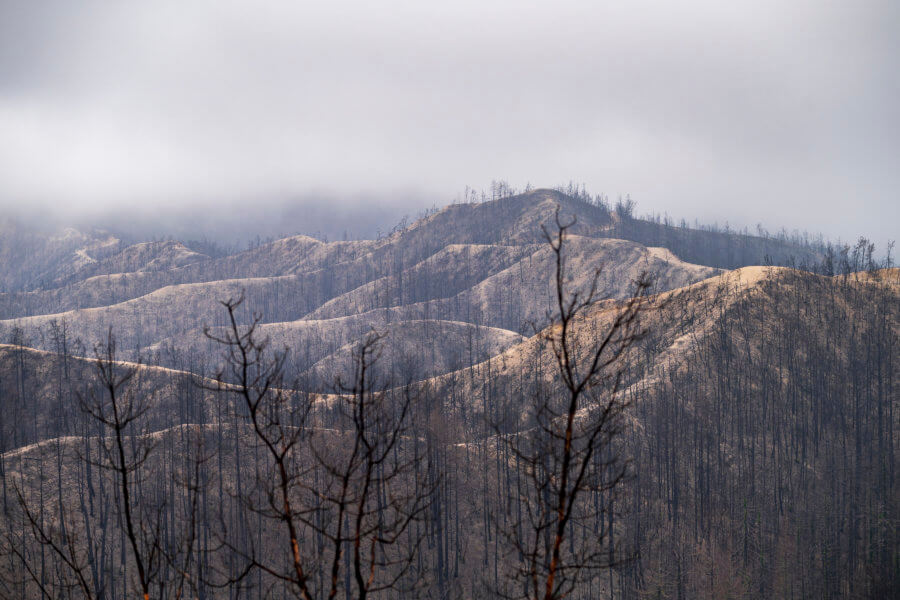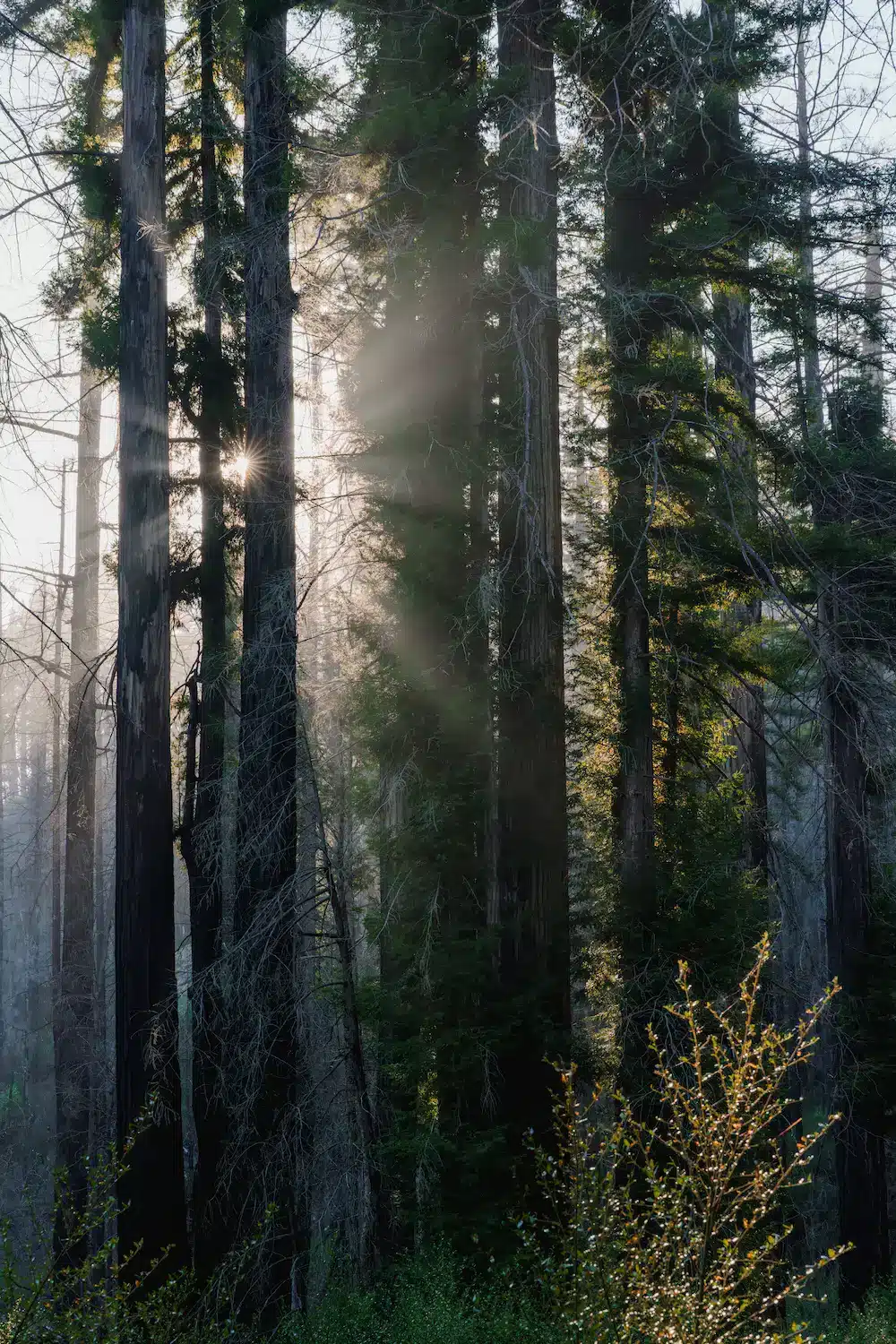Reimagining Big Basin

Damage from the 2020 CZU Lightning Complex Fire is seen at Big Basin Redwoods State Park in Boulder Creek, Calif., Friday, April 23, 2021. (AP Photo/Nic Coury)
These Redwoods Are Too Big for Small Dreams
In the weeks after the 2020 CZU fire, as wildfire still smoldered in Big Basin Redwoods State Park, we attempted to answer a tough question we were being asked repeatedly: what will the park look like in the future?
At the time, we didn’t yet know the extent of the damage to the forests themselves, but we did believe the moment was significant: an opportunity for California State Parks to reimagine, not just Big Basin, but how all state parks are cared for, how structures are built and services are delivered, and how people are invited to experience the natural wonders of the state’s parks.
Here’s what we suggested then:
We aspire for a new Big Basin that honors its historic past and is designed for the future. Big Basin should be built to last, planned for fire, and designed to coexist with both nature and people. We envision a park that models resilience to climate change, applies both scientific and Indigenous knowledge to land stewardship, and welcomes all communities to experience its redwoods with respect and inclusion. We continue to believe this. And now we know that while the CZU Lightning Complex Fire burned 97% of the entire park, almost every structure was lost, and most Douglas firs succumbed to the fire, the vast majority of redwoods survived and will recover. That’s quite simply amazing.
Reimagining Big Basin
In August 2021, California State Parks launched Reimagining Big Basin, a collaborative visioning process bringing together hundreds of Californians who met, listened, and shared their own connections to the forest. Their ideas, gathered through public workshops, advisory meetings, and surveys, informed every element of the 2025 Facilities Management Plan, which now translates that vision into practice.
From the beginning of this effort, Sempervirens Fund served as an active participant in the working group guiding strategies for forest stewardship, facility design, and recreation planning, ensuring that conservation and visitor experience were considered together.
A Framework for the Future
Building upon the Reimagining Big Basin Vision Summary, the Facilities Management Plan sets out a clear path for establishing new visitor-serving services and restoring safe access while establishing how people will experience Big Basin in the coming years. The plan protects the park’s most sensitive landscapes, leaving the old-growth forest primarily for walking, reflection, and learning. Each element reflects the public input gathered over several years and the shared values of Sempervirens Fund and California State Parks.
Key objectives include:
- Relocating visitor facilities, including parking and administration, to the new Saddle Mountain Hub, keeping intensive uses outside the old-growth redwoods.
- Building for long-term resilience, with solar energy, underground utilities, and fire-resistant design that anticipate future climate conditions.
- Integrating science and Traditional Ecological Knowledge to guide restoration of forest health, water systems, and wildlife habitat across the wider landscape.
- Preserving the old-growth experience by designing all structures within the redwood core to be minimal, resilient, and in harmony with the forest.
- Managing visitation through a shuttle system and timed entry, ensuring access remains safe and balanced with resource protection.
- More accessible trails and facilities, with new routes and restrooms that meet ADA standards so that people of all abilities can explore the forest.
- Partnering with Indigenous communities to create ceremonial spaces and shared stewardship areas at Little Basin and other significant sites.
- Restored trails and paths will replace damaged roads and reopen areas closed since the 2020 fire, giving visitors more ways to experience Big Basin while easing congestion in popular spots.
- Expanding storytelling and interpretation to reflect California’s cultural diversity and deepen visitors’ understanding of the redwood ecosystem.
Together, these priorities represent a measured but ambitious plan to revitalize Big Basin in a way that honors its past and equips it for the environmental realities of the future. They also reaffirm Sempervirens Fund’s long-standing commitment to collaborative stewardship and to maintaining Big Basin as a place where forest health, cultural heritage, and public enjoyment advance together.
Want to get involved?
Through December 1, 2025 you can comment on this plan and help shape the future of the visitor-serving facilities for Big Basin. We encourage you to participate in the public comment process through this date. Your input will ensure that Big Basin continues to evolve as a model of resilient park design by remaining open to the public, grounded in science, and faithful to the forest it protects.
Caring for the Park’s Natural Resources
The Forest Management Strategy, completed in 2024, guides how California State Parks and its partners, including Sempervirens Fund, will restore and care for Big Basin’s recovering redwood forest. It recognizes the park’s landscape as both resilient and altered, where decades of fire suppression, historical logging, and climate change have left dense and vulnerable stands.
The strategy of this plan, which you can read here, marks a deliberate return to active management, blending modern science with time-honored stewardship practices. Its core objectives include:
- Strengthen forest resilience by reducing hazardous fuel buildup and promoting a balanced mix of mature and younger trees. These management practices will create conditions that can better endure drought, storm, and fire.
- Support the safe use of prescribed and cultural fire to approximate the historical fire cycles that once shaped redwood forests, improving soil health and habitat renewal.
- Restoration will focus on maintaining the richness of native species and ensuring that wildlife can move safely through continuous habitat corridors within and beyond park boundaries.
- Re-establish stream function, meadow health, and watershed stability in response to recognizing that forest recovery depends as much on water as on trees.
- Restore traditional land-care practices through sustained collaboration with Tribal partners and ensure these lands remain places of cultural teaching and ceremony.
Together, these actions define a new standard for forest care in the Santa Cruz Mountains, an effort that treats fire, water, and growth as interdependent forces rather than opposing risks. Over two thousand acres of the park have been prioritized for initial restoration, setting a foundation for decades of adaptive management and learning.

An accompanying Environmental Impact Report examines the potential effects on the marbled murrelet, a threatened seabird that nests in the complex and high old-growth canopies. The CZU fire had an outsized impact on their nesting habitat. They prefer Douglas firs, which were decimated in the 2020 wildfire. Despite that, a murrelet sighting was captured on video in 2021. We believe that the combined planning for forest management and facilities will likely initially impact murrelet behavior, but will ultimately improve conditions at the southern end of their range. The plan also incorporates measures such as improved food storage, waste management, and visitor education to limit risk to the species.
Looking Ahead
Work at Big Basin will continue in stages over the coming years, guided by the Facilities Management Plan and the Forest Management Strategy. Together, these plans set the foundation for how the park will adapt to future conditions while protecting its ecological and cultural legacy. Sempervirens Fund strongly supports this direction and the years of collaboration that shaped it.
The scale of this work is substantial. State Parks anticipates roughly $370 million in phased investment to rebuild essential facilities, modernize infrastructure, and complete ecological restoration. That funding will come from a combination of state allocations, agency partnerships, and philanthropic support. For its part, Sempervirens Fund remains focused on the long-term stewardship of the forest: restoring redwood ecosystems, supporting climate adaptation, and ensuring the surrounding landscape continues to sustain the park’s recovery.
These plans also advance broader public goals. Legislation such as AB 679 and SB 630 will help accelerate the formal expansion of the Saddle Mountain area, reinforcing its role as Big Basin’s new headquarters and primary visitor hub. Together, these efforts move the park closer to a future where access and conservation strengthen one another.
Beyond the park boundary, we remain committed to securing and restoring lands that sustain Big Basin’s broader ecosystem. The Gateway to Big Basin property, for example, will strengthen ecological connections, support native regeneration, and provide a natural transition between the Boulder Creek community and the park’s new entrance area.
Revitalizing Big Basin is not just about recovery. It’s about renewing a covenant between people and forest, and between past and future. These redwoods have endured fire, time, and change. With care–and with all of our support–they will grow back stronger, and teach us to do the same.
More to Explore
- Read more about how Nature Needs Time to Heal
- Listen to California State Parks' Chris Spohrer introduce Reimagining Big Basin
- Learn more about the Saddle Mountain Conservation Area
